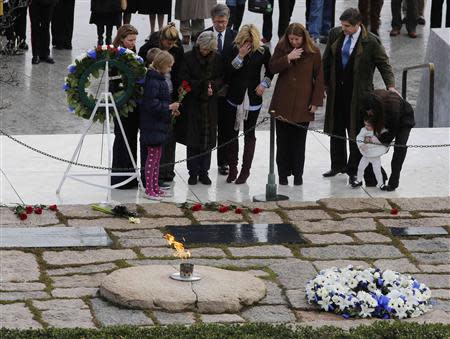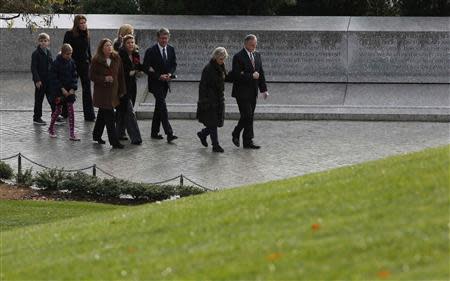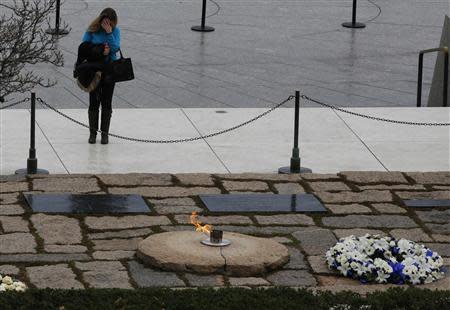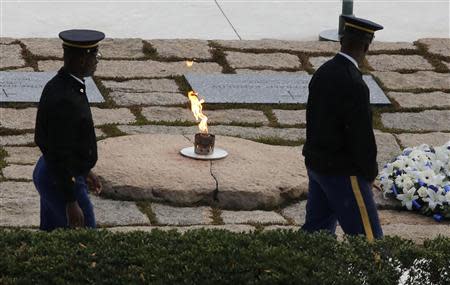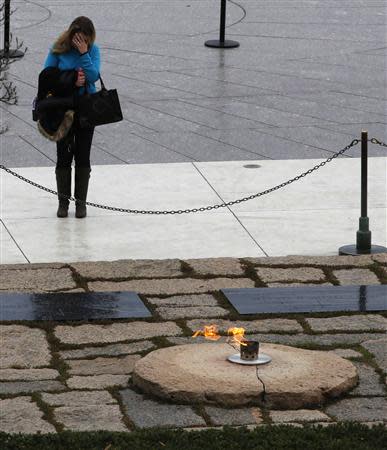On 50th anniversary of JFK death - tears, memories, suspicion
By Jon Herskovitz and Marice Richter DALLAS (Reuters) - President John F. Kennedy was remembered with prayer, song and tears in Dallas on Friday, the 50th anniversary of his assassination, as the city held its first official ceremony marking an event seen as the darkest day in its history. "Our collective hearts were broken," Dallas Mayor Mike Rawlings told a crowd of about 5,000 who came to a frigid Dealey Plaza, where Kennedy was slain while riding in a motorcade. Remembered fondly for his youthful vigor and glamorous wife, Kennedy remains one of Americans' favorite presidents for his handling of the Cuban missile crisis, his call to public service with programs such as the Peace Corps, and a promise - later fulfilled - to land an American on the moon before the end of the 1960s. "A new era dawned and another waned a half century ago when hope and hatred collided right here in Dallas," Rawlings said. The assassination cut short "Camelot," as the 1,000 days of the Kennedy presidency became known. He was 46 when he died. "If that hadn't happened, history might have changed. He was a different kind of president," said Douglas Ducharme, a Canadian attending the event. There were a few scuffles along the perimeter fence around Dealey Plaza between police and protesters, including conspiracy theorists who wanted to take part in the official event and others who sought attention for their concerns about what they consider police brutality in Dallas. In previous years, conspiracy theorists gathered in Dealey Plaza to express their doubts of the official Warren Commission conclusion that gunman Lee Harvey Oswald acted alone, shooting Kennedy to death from the sixth floor of the Texas School Book Depository as the president rode in an open limousine. Two days after the assassination, Dallas nightclub owner Jack Ruby shot Oswald to death on live television while he was in police custody. Ruby died in prison in early 1967. WREATH AT THE GRAVE At Arlington National Cemetery in Virginia where Kennedy is buried, family members laid a wreath at his grave, where Kennedy's wife, Jackie, and two of their children also are buried. At dawn, Attorney General Eric Holder made a gravesite visit to honor Kennedy, bowing his head and placing a Justice Department commemorative coin at the stone. Holder then walked a short path to the grave of Robert F. Kennedy, who served as attorney general under his brother and was assassinated in 1968 while running for president. Holder bowed his head and left another coin. President Barack Obama, who visited John F. Kennedy's grave on Wednesday, observed a moment of silence for the slain president. He told Barbara Walters of ABC News that he did not dwell on his own safety because he was well protected by the U.S. Secret Service. At the John F. Kennedy Library and Museum in Boston, a steady stream of people came to view artifacts, including a video of Kennedy's state funeral and a display of the saddle, sword and boots of Black Jack, the riderless horse that led the procession. Hundreds of people also lined up to write their thoughts and sign their names in four large guest books set up at the museum. "Some people view Kennedy's assassination as the moment the nation lost its innocence," said Alex Loughran Lamothe, a 23-year-old volunteer for City Year - an organization modeled on Kennedy's Peace Corps program - who was helping at the exhibit. Across the country in Santa Rosa, California, former Dallas-area resident Ruth Paine, an acquaintance of Oswald and friend of his Russian-born wife in the months before the assassination, said she spent the anniversary in seclusion. Paine, now 81, who told the Warren Commission she helped Oswald get a job at the book depository, has appeared in recent documentaries recounting how investigators determined that Oswald had, unknown to her, kept the rifle identified as the murder weapon stashed in her garage. Reached by telephone on Friday, she told Reuters, "I've spent the day in retreat," and declined to comment further. New York tabloids on Friday included inserts of their reprinted 1963 editions reporting on the Kennedy assassination. The New York Post, which at the time was an afternoon newspaper, ran an extra edition on November 22, 1963, that cost 10 cents and was headlined "JFK SHOT TO DEATH" with a stock portrait photograph of Kennedy. STIGMA Dallas was seen as a pariah city for years after the assassination. That stigma started to fade decades ago, and now, the Sixth Floor Museum in the former Texas School Book Depository - where police found Oswald's rifle - is one of the city's biggest tourist attractions. "Dallas came under a great deal of international criticism after the assassination. It was called the 'City of Hate,'" said Stephen Fagin, associate curator of the museum. Amid the Cold War paranoia and simmering racial tension of the 1960s, a small but influential group of arch-conservatives protested Kennedy's visit to Texas, saying he was soft on communism and should stay away. In recent days, the city removed a large "X" embedded into the pavement by an unknown person or people that marked the spot on Elm Street where Kennedy was shot in the head. The "X" had been seen as tasteless by many, while the official observance - a small plaque on the plaza's noted "grassy knoll" - had been criticized as inadequate. CONSPIRACY THEORY The conspiracy theorists also came to Dallas for the 50th anniversary but were left out of the official event, with one group gathering at a nearby sandwich shop. Thousands of books, news articles, TV shows, movies and documentaries have been produced about that fateful day in Dallas, and surveys show a majority of Americans still believe in the conspiracy theories, distrusting official evidence that points to Oswald as the sole killer. Despite serious questions about the official inquest, and theories purporting that organized crime, Cuba or a cabal of U.S. security agents was involved, conspiracy theorists have yet to produce conclusive proof that Oswald acted in consort with anyone. Hugh Aynesworth, a reporter in Dealey Plaza 50 years ago who witnessed the assassination and also saw Oswald killed by Ruby, has spent a lifetime investigating the killings and debunking suspected plots. "We can't accept very comfortably that two nobodies, two nothings - Lee Harvey Oswald and Jack Ruby - were able to change the course of world history," he told Reuters. (Additional reporting by Barbara Goldberg in New York, David Ingram in Arlington, Brian Snyder and Richard Valdmanis in Boston, Pavithra Sarah George in Dallas; Editing by Daniel Trotta, Gary Hill and Peter Cooney)

